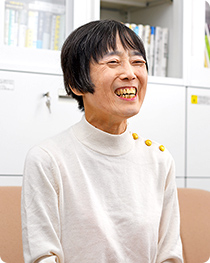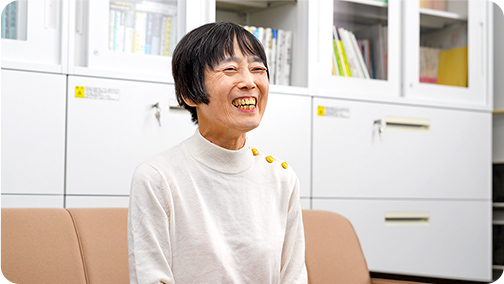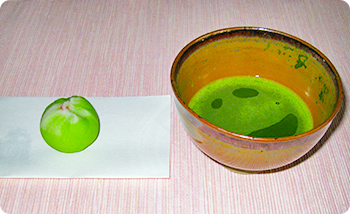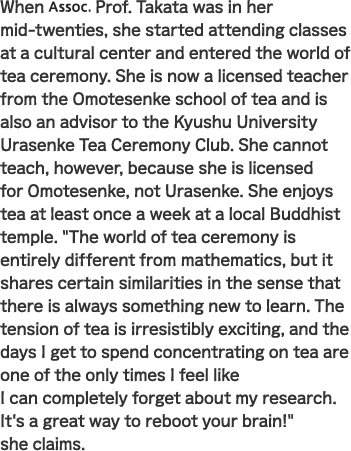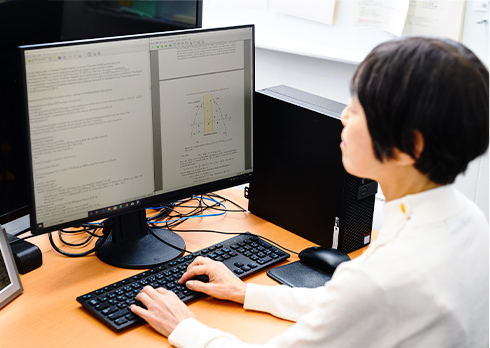 A: Trivial Knot | B: Trefoil Knot
A: Trivial Knot | B: Trefoil Knot
By coloring the knots, we can clearly see that they are not the same.
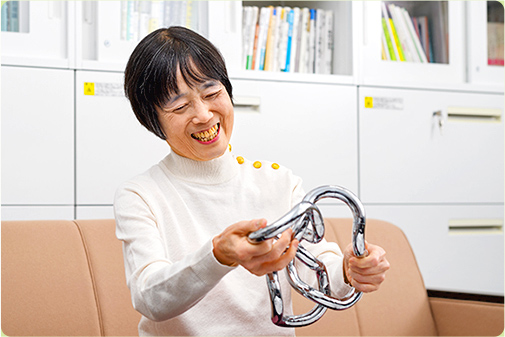 Assoc. Prof. Takata explains her research using a knot model. Strewn about the lab are stuffed animals still in their packaging. When asked why, she replies coyly, "I don't want to get them dirty..."
Assoc. Prof. Takata explains her research using a knot model. Strewn about the lab are stuffed animals still in their packaging. When asked why, she replies coyly, "I don't want to get them dirty..."
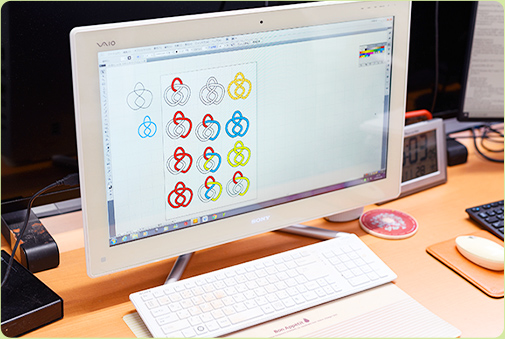 Diagraming knots is an essential part of preparing any research paper. A knot is proved by coloring each arc in a figure either red, blue, or green.
Diagraming knots is an essential part of preparing any research paper. A knot is proved by coloring each arc in a figure either red, blue, or green.
 A: Trivial Knot | B: Trefoil Knot
A: Trivial Knot | B: Trefoil Knot
By coloring the knots, we can clearly see that they are not the same.
First, let's talk about what knots are, their rules and definitions, and how we study them. Everyone knows that when you tie a string around a package, you try to tie it so that it won’t come loose. But in mathematics, knots are actually closed loops, where the two ends of a string are fused together. The simplest knot is one where the two ends of a string join to form a circle, which we call a trivial knot, or unknot. A rubber band is a perfect example of an unknot.
 Assoc. Prof. Takata explains her research using a knot model. Strewn about the lab are stuffed animals still in their packaging. When asked why, she replies coyly, "I don't want to get them dirty..."
Assoc. Prof. Takata explains her research using a knot model. Strewn about the lab are stuffed animals still in their packaging. When asked why, she replies coyly, "I don't want to get them dirty..."
Knot theory, however, is the study of whether loops containing entanglements, or un-trivial knots, are the same or not. Take a look at Fig. 1. At first glance, A and B seem to be the same loop. In practice, however, loop A can be unwound while loop B cannot. And we can prove that A ≠ B by showing that the mathematical quantities computed for the knots take different values for A and B. As a side note, B is a knot known as the trefoil knot, named for its resemblance to a three-leaf clover.
 Diagraming knots is an essential part of preparing any research paper. A knot is proved by coloring each arc in a figure either red, blue, or green.
Diagraming knots is an essential part of preparing any research paper. A knot is proved by coloring each arc in a figure either red, blue, or green.
A point where one piece intersects above or underneath another is called a crossing. In mathematics, the number of crossings can increase indefinitely, and the more crossings there are, the more complicated the knot becomes. Physical models can be made to predict simple knots like the one in the example above, but the more crossings there are, the more difficult it is to make such models. For such intricate knots, we use something known as a knot invariant. Because invariants have the same value for the same knot, if the values of the invariants for A and B are different, we can prove that A ≠ B. A well-known invariant is the Jones polynomial. Since its discovery, the theory of polynomial invariants of knots has developed significantly and has had a major impact on fields outside of math. There are currently more than 10,000 known knots with 14 classes of crossings, and we expect that the number of classes will only continue to grow. Finding powerful invariants that prove knot classification differences is a major research goal and dream of mine.
Although mathematics has been used in measurement and record-keeping for more than 2,000 years, knot theory is a relatively young field that only began in the 19th century. In recent years, expectations for the field have been on the rise in hopes applications will be found in various fields. Take genetics, for example. Since DNA is itself a kind of knot, knot theory may be able to determine whether two DNA structures are the same or not without the need for experimentation, and this could lead to predicting mutations, including those of intractable diseases. One familiar example is its application in graph theory when considering optimal configurations for subways, expressways, electrical circuits, and more. I conduct basic research, which means that it's done before considering real-world applications and, honestly, I don't know how it will be of use to society yet. But for me, I find joy in simply investigating knots and finding regularities in mathematical formulas. I think this kind of that innate human curiosity is what led to the development of mathematics in the first place and has also contributed to the growth and progress of society across all fields, including medicine and science.


In mathematics, no matter how difficult the problem, there is always an answer. Finding those answers is both the reward and the motivation for my research. The more elegant a solution or proof, the more beautiful—and the cooler—it is. And thought is all that is required for math. That’s another thing that makes math special: you can compete on the world stage using only your mind, regardless of gender or any other factor.
In the world of math, there are times when a sudden breakthrough leads to an increase in research materials and methods. Luckily for me, this happened when I started studying knot theory during the first year of my master’s program. At the time, we often made predictions based on a small amount of data obtained from calculating formulas by hand, but today it is much more common to make predictions and proofs using computers to generate the data from a large number of formulas. By plugging away at finding commonalities among huge sequences of generated numbers, we are able to find new solutions.
I can still remember the thrill I felt finding the answer to a geometry problem in elementary school just by drawing an auxiliary line! Put simply, my basic research lays the groundwork for the applied research that has an impact on the world. The world of mathematics is infinite, but it can be a challenge to create something from nothing. It's hard to express in words the sheer joy and sense of accomplishment you feel when you do.
![]()
![]()











